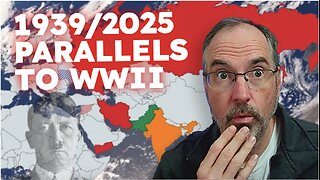Premium Only Content

Months of BOMbs
Operation Meetinghouse was the codename for one of the most devastating air raids conducted by the United States during World War II. It took place on the night of March 9-10, 1945, when the U.S. Army Air Forces launched a massive firebombing campaign against the city of Tokyo, Japan.
Approximately 334 B-29 Superfortress bombers dropped over 1,600 tons of incendiary bombs on the densely populated residential and industrial areas of Tokyo. The incendiaries, designed to create massive firestorms, caused widespread destruction, turning large parts of the city into an inferno. The attack was particularly destructive due to the largely wooden construction of Japanese buildings at the time.
The resulting firestorm was one of the deadliest in history, causing immense loss of life and extensive damage. The estimated number of casualties from the Tokyo firebombing varies, but it is commonly believed to have resulted in the deaths of over 100,000 civilians, with many more injured and a million left homeless. The human toll and destruction were immense, making it one of the most controversial and tragic events of the Pacific War.
Operation Meetinghouse was a key element in the strategic bombing campaign against Japan and played a role in the eventual surrender of Japan in August 1945. However, it remains a subject of ethical debate due to the high civilian casualties and the use of area bombing tactics during the war.
-
 6:26
6:26
Adam Does Movies
19 hours ago $3.35 earnedSuperman | Official Trailer - Reaction!
25.6K3 -
 31:05
31:05
Ohio State Football and Recruiting at Buckeye Huddle
18 hours agoOhio State Football: Five Breakout Players for the Buckeye Offense in 2025
17.8K5 -
 12:50
12:50
Professor Gerdes Explains #Ukraine
11 hours agoAre we on the Brink of WWIII: 1938-39’s Grim Clues!
23.4K4 -
 18:08
18:08
Clownfish TV
16 hours agoCartoon Network is DYING.
17.7K15 -
 13:39
13:39
IsaacButterfield
1 day ago $1.13 earnedThese Trans Influencers Are Unbelievable (Insane TikTok Compilation)
22.6K7 -
 1:04:51
1:04:51
DrEverettPiper
1 day agoThe Rise and Fall of the Old Mainstream Media
18.4K6 -
 24:19
24:19
ArturRehi
20 hours agoPUTIN and ZELENSKY meeting in Turkey?! | Putin’s bluff got called | Ukraine update
22.5K15 -
 9:36
9:36
Ariston Production from Macedonia
2 days agoThe oldest lake in Europe is in Macedonia | Lake Ohrid and the city of light
18.6K1 -
 8:06
8:06
The Shannon Joy Show
16 hours ago⚠️The Middle East is Coming to America!🔥
18.3K8 -
 50:06
50:06
Lets Read!
1 day ago $2.18 earned4 True Creepy New Town Stories
26.3K11